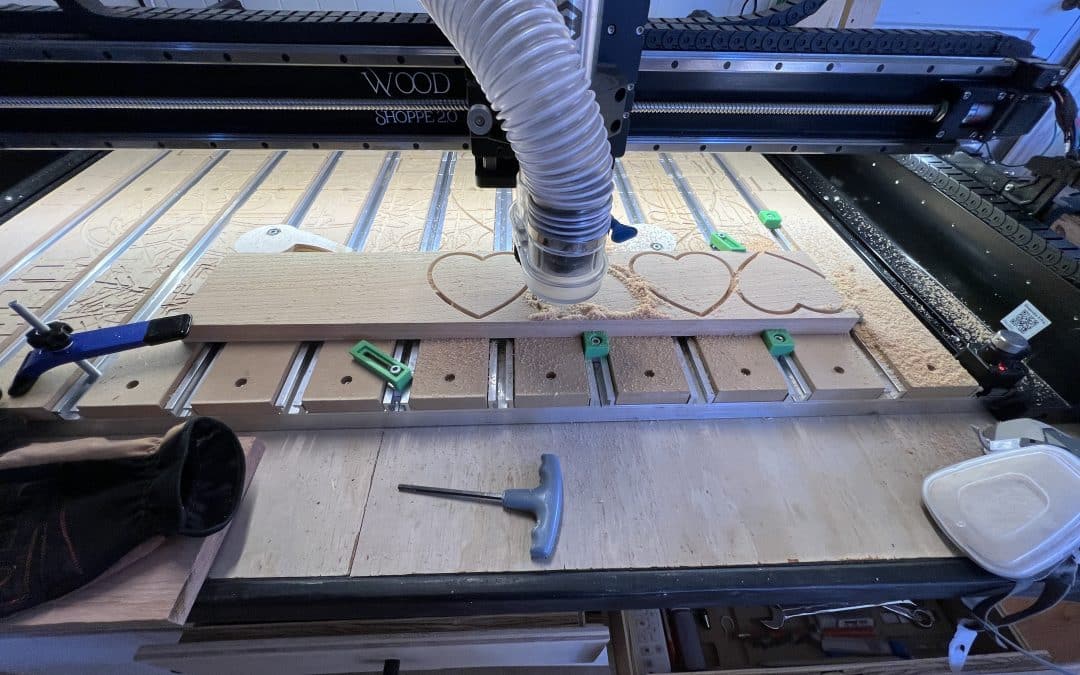If you’re a helicopter CNC operator, that’s not all bad.
If you’ve been around CNC machines for any length of time, you’ve probably seen or experienced it: the CNC operator who stands over the work table like a hawk, eyes locked on the spindle, ears tuned for the slightest change in pitch.
Every chip, every pass, every whiff of burning wood — they’re on it.
Much of the time, I’m like this, too, and I do not regard this as something with a negative connotation.
If your CNC goes off track, you want to be able to stop it.
Fast.
Before that bit … snaps.
The Helicopter CNC Operator.
Much like the proverbial “helicopter parent” who hovers over their kid at the playground, the helicopter CNC operator can’t walk away while a job is running.
Maybe it’s fear of ruining expensive stock.
Perhaps it’s a habit.
Or maybe it’s the adrenaline rush of hearing a 1/4″ end mill chewing through walnut.
For me, it’s almost a year’s experience now of trial, error, feed rates that are too high, and/or toolpaths I didn’t set up quite right.
The Pros and Cons of Hovering.
Along my CNC journey this past year, I have broken a few bits from having mistakenly put in a feed rate that was too high.
Maybe I was using a rate that was suggested by the seller for the same bit, but while it was running on a non-hobby machine.
Maybe I was nervous about how those v-carve lines were going I wanted to ensure they were deep enough.
Maybe there was a question about how flat my spoil board was and the right side cuts were going through the board an extra 0.03″ inches and not tearing up the spoil board. And maybe it was frustration that for some reason, the 0.75″ cutting depth was only going 0.67 deep on the left and I couldn’t figure out why.
Regardless, keeping an eye on one’s CNC while it’s running isn’t a bad idea. Here’s why:
Why Hovering Has Its Upside.
-
You can catch a mistake before it becomes scrap.
-
You can pause the run if a bit snaps, the stock shifts, or the cut quality tanks.
-
You know exactly what happened if something goes wrong.
But other aspects of a project can also be accomplished while a project is running on the CNC.
Why Hovering Can Hurt You
-
It’s a time sink — you can’t get other shop work done.
-
It leads to fatigue, especially on long jobs.
-
It can keep you from learning to trust your setup.
Siren Song of a CNC.
Even after a year of use, hearing the scream of a CNC bit as it rips through a piece of maple or walnut is much like descriptions of ancient sailors mesmerized by a Siren Song.
It’s a little haunting, calming, and yet dream-inspiring to watch and listen as a bit like Cutting It Close Workshop’s 1/4″ upcut Golden Girl rips through some maple at 18,000 rpm with a feed rate of 90. Just don’t, at least on a Shapeoko 5 Pro, go much higher than that!
There’s been many a time when I’ve found myself sitting there, ear protection on, and unable to get up from watching the spindle and bit do their thing.
And then there’s the ‘Pfff, it’ll be fine’ guys.
I’ve not met many of them, but on the flip side, you’ve got the Set-It-and-Forget-It crowd.
These foke dial in the job, hit “Run,” and go joint boards, sand parts, or grab lunch.
Maybe cause they’ve sweated all the details in Fusion.
Maybe they are the kind of CNC operator who built their own machine.
Or, perhaps, they’ve got more time running their feed and plunge rates, they just instinctively know.
Regardless, I admire them. And I will admit, my desire is to be more so in their crowd.
I’m working to become more comfortable, you know, to feel just comfy enough with the process to be within earshot–able to recognize when the pitch has changed just enough to warrant a pause from another activity and revisit what’s going on at the CNC.
I’ve had this work both ways on me. While cutitng some of the initial prototypes of the Five Star Puzzles, a 1/16″ bit dug into some MDF all in a bad way and it was not pretty.
The sweet spot?
Check your first passes, trust your workholding, and know the material.
Time teaches you when something is amiss. Just a little change in pitch in the whine of the machine says so much!
I’ve thought about aiming a Blink camera at the CNC so I can move about. But that seems impractical. If I’ve stepped out of the shop and into the house to refresh my thermal cup, I need to be doing that, not walking around with my phone in hand.
The obvious medium is to hover when it makes sense, drift away when the risk seems low.
What about you? Drop a comment below: Are you a Helicopter CNC Operator, a Set-It-and-Forget-It type, or somewhere in between?
CIC Academy for CNC Operators
Donald J. Claxton is a member of Ryan Drapela’s CIC Academy hosted via Skool.com.

